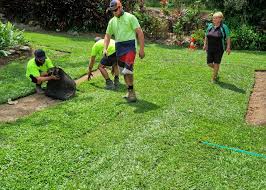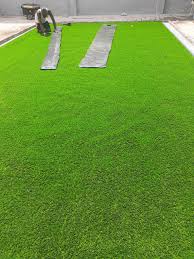Carpet Grass (Axonopus affinis) is a resilient and versatile warm-season grass that is gaining popularity for its unique attributes and low-maintenance requirements. This fine-textured grass is often sought after for its ability to create a lush and dense carpet-like appearance, making it an excellent choice for lawns, parks, and other landscaping projects.
One of the standout features of carpet grass is its adaptability to various soil types and conditions. It thrives in both sandy and clay soils, making it well-suited for a wide range of environments. This adaptability is particularly useful in areas where other grass species might struggle to establish themselves.
Carpet grass’s ability to tolerate partial shade is another reason for its growing popularity. Unlike some other warm-season grasses that require full sun exposure, carpet grass can flourish in areas with limited sunlight, making it an excellent option for lawns with trees or buildings casting shadows.
Homeowners and landscapers alike appreciate carpet grass for its minimal maintenance needs. It has a relatively low growth rate compared to some other grass species, resulting in reduced mowing frequency. Additionally, carpet grass has a natural resistance to pests and diseases, which contributes to its overall resilience and long-term health.
While carpetgrass offers numerous advantages, there are some considerations to keep in mind. Its slow growth can mean a longer establishment period, requiring patience during the initial phase of lawn development. Additionally, it may not tolerate heavy foot traffic as well as other grass types, so it’s important to manage usage accordingly.
In addition, carpetgrass presents an appealing option for those seeking a lush, low-maintenance lawn in warm climates. Its adaptability, shade tolerance, and resistance to pests and diseases make it an attractive choice for a variety of landscaping projects.
Whether it’s for a residential yard, a park, or a commercial property, carpet grass has proven itself as a reliable and visually appealing ground cover.
Read Also: History, Domestication, Physical Traits, & Breeds of Dogs
Complete Growing and Care Guide of Carpet Grass

Here’s a comprehensive guide for growing and caring for carpet grass in your lawn:
1. Site Selection: Choose a location that receives moderate sunlight. Carpet grass is known for its shade tolerance, but it still requires some sun exposure for optimal growth. Avoid areas with heavy foot traffic, as carpet grass is not as durable as some other grass species.
2. Soil Preparation: Prepare the soil by removing debris, rocks, and weeds. Conduct a soil test to determine pH and nutrient levels. Carpet grass prefers slightly acidic to neutral soil with a pH range of 5.5 to 6.5. Amend the soil as necessary to achieve the desired pH and improve soil structure.
3. Seeding or Sodding: You can establish carpet grass through seeding or sodding. If seeding, choose a high-quality carpet grass seed blend. Sow the seeds evenly using a broadcast spreader. For sodding, prepare the area and lay the sod pieces with proper spacing.
4. Planting Time: Plant carpet grass in late spring or early summer when soil temperatures consistently reach 70°F (21°C) or higher. This period provides optimal conditions for rapid germination and establishment.
5. Watering: Keep the soil consistently moist during the germination phase, which typically takes about 2-3 weeks. Water lightly but frequently to prevent the soil from drying out. As the grass establishes, reduce watering frequency and allow the soil to dry slightly between waterings.
6. Mowing: Begin mowing when the carpet grass reaches a height of about 3 inches. Set your lawnmower to a height of 2 to 2.5 inches for the initial cut. Subsequent mowings can be slightly shorter. Never remove more than one-third of the grass height in a single mowing to avoid stressing the plants.
7. Fertilization: Apply a balanced fertilizer with an N-P-K ratio of around 3-1-2 after the first mowing. Follow the manufacturer’s guidelines for application rates. Fertilize every 6-8 weeks during the growing season to promote healthy growth.
8. Weed Control: Regularly inspect the lawn for weeds and remove them manually. Use a pre-emergent herbicide in early spring to prevent weed growth. If using herbicides, choose those labeled safe for use on carpet grass.
9. Maintenance: Carpet grass has a slow growth rate, which means less frequent mowing compared to other grass types. Maintain a mowing height of 2 to 3 inches. Water deeply and infrequently to encourage deep root growth. Aerate the lawn annually to improve soil compaction.
10. Shade Management: While carpetgrass is shade-tolerant, ensure that the lawn receives some sunlight. Trim overhanging branches or thin out nearby trees to provide adequate light to the grass.
11. Pest and Disease Management: Monitor the lawn for pests like chinch bugs and diseases like brown patch. Proper watering practices and maintaining a healthy lawn can help prevent these issues.
12. Overseeding: Every few years, consider overseeding your carpet grass lawn to maintain its density and fill in thinning areas.
13. Winter Care: Carpet grass may turn brown during winter months in colder climates. It will recover its green color as temperatures rise in spring. Reduce foot traffic on dormant grass to prevent damage.
By following this comprehensive guide, you can successfully establish and maintain a vibrant and healthy carpet grass lawn that adds beauty to your outdoor space. Remember that each lawn is unique, so observing and adjusting care practices based on your lawn’s specific needs is crucial for long-term success.
Read Also: Doberman Dogs: Description and Complete Care Guide
Importance and Uses of Carpet Grass

Carpetgrass (Axonopus affinis) holds significant importance and offers a range of uses in landscaping, agriculture, and environmental conservation. Here are some of its key importance and uses:
1. Lawn and Landscaping: Carpet grass is prized for its ability to create a lush, carpet-like appearance in lawns and landscapes. It adds aesthetic value to residential yards, parks, golf courses, and other green spaces. Its fine-textured blades and dense growth habit contribute to an attractive and visually pleasing outdoor environment.
2. Soil Erosion Control: Due to its dense growth and mat-forming nature, carpet grass is often used for erosion control on slopes and embankments. Its extensive root system helps stabilize soil and prevent erosion, making it a valuable tool in managing soil loss on landscapes and construction sites.
3. Pasture and Forage: In some regions, carpet grass is utilized as a forage grass for livestock. While not as high in nutritional value as some other grass species, it can provide a source of grazing in areas with moderate livestock requirements.
4. Low-Maintenance Lawns: Carpet grass is renowned for its low-maintenance requirements. It requires less frequent mowing compared to other grass types, reducing the time and effort needed for lawn care. This makes it an appealing choice for those seeking a visually pleasing lawn without constant upkeep.
5. Shade Tolerance: Carpet grass’s ability to tolerate partial shade makes it an excellent option for areas with trees or structures that cast shadows. It can thrive in conditions where other grass species struggle to establish themselves, providing ground cover in shaded environments.
6. Biodiversity and Habitat Enhancement: In environmental restoration projects, carpet grass can be used to enhance biodiversity by providing ground cover and habitat for insects, birds, and small mammals. It contributes to the ecological balance of an area and supports local wildlife.
7. Weed Suppression: Once established, the dense growth of carpet grass can help suppress weed growth by shading the soil and limiting weed germination. This can reduce the need for excessive herbicide use and promote a healthier ecosystem.
8. Soil Improvement: Carpet grass’s root system helps improve soil structure and increase soil fertility. As it grows, it adds organic matter to the soil and enhances its ability to retain moisture and nutrients.
9. Soil Stabilization: Apart from erosion control, carpet grass can stabilize soil in areas prone to compaction or surface runoff. Its mat-forming growth habit reduces soil compaction and prevents water from washing away the topsoil.
10. Carbon Sequestration: Like all plants, carpet grass contributes to carbon sequestration, helping to mitigate the effects of climate change by capturing and storing carbon dioxide from the atmosphere.
In summary, carpet grass plays a vital role in landscaping, erosion control, low-maintenance lawns, shade-tolerant environments, and even contributes to ecological diversity. Its adaptability, resilience, and various uses make it a valuable asset in enhancing outdoor spaces, conserving natural resources, and supporting both aesthetic and functional goals.
Read Also: The Evolution of Marketing
